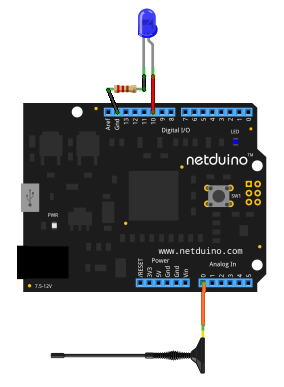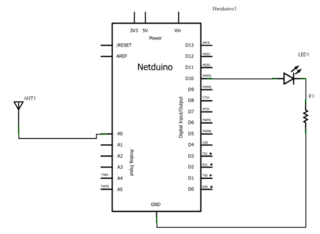This is my first topic and project for Netduino platform. I still don't have mine yet, UPS bastards missed-up the shipment ):
I thought I could start programming and I tried to make EMF Detector similar to the one for Arduino by: Aaron ALAI’s EMF detector project.
I'm not sure if it's working correctly and I hope if anyone kindly could check it.


using System;
using System.Threading;
using Microsoft.SPOT;
using Microsoft.SPOT.Hardware;
using SecretLabs.NETMF.Hardware;
using SecretLabs.NETMF.Hardware.NetduinoPlus;
namespace NetduinoPlus_EMF_Detector
{
/// <summary>Original Project: Aaron ALAI’s EMF detector project for the Arduino.</summary>
/// <remarks> http://www.aaronalai.com/emf-detector </remarks>
public class Program
{
public static void Main()
{
const uint SAMPLES = 300; // No. of samples the device takes per reading.
AnalogInput analogInput = new AnalogInput(Pins.GPIO_PIN_A0); // Assign analog PIN A0 as input port.
PWM led = new PWM(Pins.GPIO_PIN_D10); // Assign GPIO PIN D10 as LED output port.
uint dutyCycle = 0; // LED 8-bits output value: 0-255 (always off)-(always on). Default OFF.
float avarage = 0.00f; // var holding the avarage of all samples.
ulong sum = 0L; // var holding the sum of all samples.
int[] readings = new int[SAMPLES]; // array holding actual samples.
while (true) // loop infinitely
{
for (uint i = 0; i < SAMPLES; i++)
{
readings[i] = analogInput.Read(); // read data from the antenna wire.
Thread.Sleep(10); // allow system to complete proccessing.
sum += (ulong)readings[i]; // calculate sum.
}
avarage = sum / SAMPLES; // calculate the avarage of all samples.
dutyCycle = (uint)constrain((long)avarage, 0, 100); // constrains the avarage value to between two numbers 0 and 100
dutyCycle = (uint)map((long)avarage, 0, 100, 0, 255); // maps out 0-100 to 0-255, 255 is the threshold of analog to digital conversion.
led.SetDutyCycle(dutyCycle); // set the duty cycle value of LED.
Thread.Sleep(10); // allow system to complete proccessing.
// clean-up
dutyCycle = 0;
avarage = 0.00f;
sum = 0L;
}
}
/// <summary>
/// Constrains a number to be within a range.
/// </summary>
/// <param name="value">the number to constrain, long data types.</param>
/// <param name="low">the lower end of the range, long data types.</param>
/// <param name="high">the upper end of the range, long data types.</param>
/// <returns>
/// <para>value: if value is between low and high.</para>
/// <para>low: if value is less than low.</para>
/// <para>high: if value is greater than high.</para>
/// </returns>
/// <example>
/// <para>val = constrain(val, 0, 100);</para>
/// <para>// limits range of val to between 0 and 100.</para>
/// </example>
/// <remarks>
/// See: http://arduino.cc/en/Reference/Constrain
/// </remarks>
public static long constrain(long value, long low, long high)
{
return value >= high ? high : value <= low ? low : value;
}
/// <summary>
/// Re-maps a number from one range to another.
/// </summary>
/// <param name="value">x: the number to map, long data types.</param>
/// <param name="fromLow">the lower bound of the value's current range, long data types.</param>
/// <param name="fromHigh">the upper bound of the value's current range, long data types.</param>
/// <param name="toLow">the lower bound of the value's target range, long data types.</param>
/// <param name="toHigh">the upper bound of the value's target range, long data types.</param>
/// <returns>
/// The mapped value.
/// </returns>
/// <remarks>
/// See: http://arduino.cc/en/Reference/map
/// </remarks>
public static long map(long value, long fromLow, long fromHigh, long toLow, long toHigh)
{
try
{
return (value - fromLow) * (toHigh - toLow) / (fromHigh - fromLow) + toLow;
}
catch (Exception ex)
{
throw ex;
}
}
}
}















